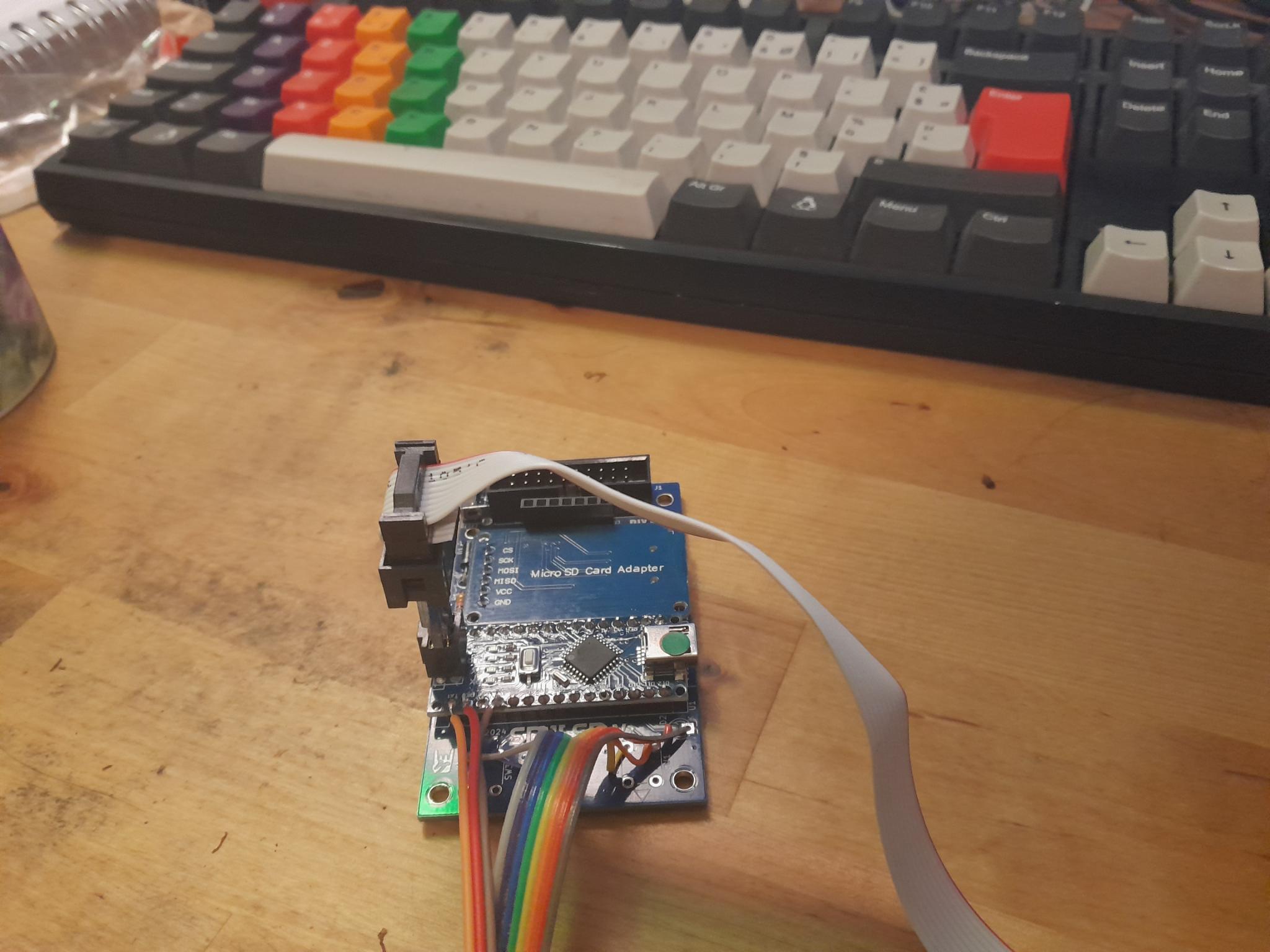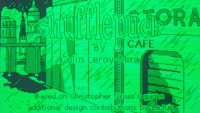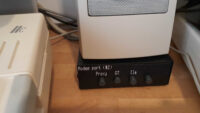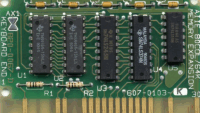The SPIISD is one of the rare possibilities to add mass storage to a non-slotted Apple //c. The other ones are the FloppyEMU, which is a great, mature product by great, nice people, but it is expensive and closed-source. A second solution I know of is the soon to come Xdrive2c, also more expensive and closed-source. There is also this, but it never saw the light of day. There is the Fujinet, which is a good product, a bit on the expensive side, does much more than storage, and harder to DIY. And finally, there is the AppleIIDiskIIStm32F411 which seems to be a really good product, cheap and full-featured, but for which development seems harder (to me).
I wanted to add mass-storage to my Apple //c, so I chose the SPIISD option: a good, cheap solution was an SPIISD v2 kit.
Why this fork?
But. My use-case is to be able to save documents, photos, programs to a large storage, because floppies are… small, but still be able to boot my existing floppies from the internal floppy disk drive.
Upon testing, I was disappointed to see that the SPIISD v2 works great, in conjunction with ROM4x, when I boot the Apple //c from Smartport using the ROM4x menu, but that the drive was “invisible” when booting from the internal floppy disk drive.
I was told this was a limitation of the Apple //c firmware, but could not believe it, as it was documented nowhere on Internet, and people back in the day would have had a hard time booting from an external hard disk drive without any means to initialize it.
This is when the second disappointment happened: I wanted to investigate the problem, but when I bought the SPIISD v2, I missed the part in the documentation that says that the v2 firmware is closed-source. I doubt the legality of this, given that serial logs similarity give me the impression that it is heavily based on the v1.17 firmware – which is MIT-licensed – but that is not my main problem so far, as I so far had no copyright on v1.17. I was mostly annoyed that I couldn’t debug anything further than looking at serial logs.
I traced the PCB connections from the IDC-20 Smartport connector to the Nano, and the ones from the SD card module to the Nano, ignored the four buttons and the screen, and compared those to the gerber files for the v1 board (those are here). All connections matching, I flashed the v1.17 firmware on my v2 board, and started debugging.

So far, I fixed my problem: the SPIISD board was booting too slowly, and missed the first Smartport RESET and ENABLE at cold boot, and so could not advertise its existence to the Apple //c.
I solved it by reflashing the firmware using an AVR ISP mkII programmer, which bypasses the Arduino’s bootloader. As this was not enough, I defer slow inits to after having replied to the computer. I shared those findings with Kay of Kero’s Mac Mods.
I have an official SPIISD and the same problem, how do I fix it
If you’re here because you want your Apple IIc to see your SPIISD (v1 or v2) on cold boot, here are your options:
- Hit Ctrl-Open-Apple-Reset one second after cold booting. This re-resets the Smartport bus, but this time the SPIISD is booted.
- Power your SPIISD via an USB adapter, so that it’s on before the //c
- Flash this firmware to your board, using a programmer instead of the USB connection, to fix the root of the problem.
Warning: If you flash my firmware on an SPIISD v2 board, you will lose the screen and buttons functionalities. If you flash this firmware on a v1 board, you will lose the “Eject” button that is used to switch the SPIISD’s bootable image.
In any case, backup your original firmware, using (via USB connection to the nano):
avrdude -c arduino -P /dev/ttyUSB0 -b 115200 -p m328p -U flash:r:SPIISD.orig.hexIf needed, you can restore it by first using the arduino IDE to reflash the bootloader:
- Tools / Board : Arduino Nano
- Tools / Processor : ATmega328P
- Tools / Programmer: AVR ISP mkII (or whatever your programmer is)
- Tools : Burn bootloader
Then reflash the firmware using your backup:
avrdude -c arduino -P /dev/ttyUSB0 -b 115200 -p m328p -U flash:w:SPIISD.orig.hexDirections for this project
I am not yet sure what I want to do with this project. I would like to have my firmware conform to my needs (for example, I need only one or two partitions, and I dislike seeing S2D1 and S2D2 when I won’t use them). I would also like it to be a good, solid Smartport hard drive implementation that would benefit the community at large: while it is easy to find mass storage solutions for the slotted Apple IIs, there are far less options to the //c, and as far as I know, only one – the out-of-stock SPIISD v1 – is open-source.
So, if people are interested in such a project, I’m in. I am bad at hardware, and while I can wire shit to the correct pins to make prototypes, I have zero experience at making PCBs and each time I try to learn it’s a nightmare. I’m also bad at 3D printing and couldn’t design and print an enclosure. But I’m quite good at software.
So far, only huge nerds can use this firmware: it requires competency in Arduino flashing and in what to do to transform gerber files into PCBs: the v1 board is out of stock at Kero Mac Mods store, and the PCB is licensed under the CC-BY-NC-SA, which prohibits others to step up, have some built and sell them to the community. (Or, you could by a v2 board and use this firmware. Still, it’s not as easy as it should).
So what I would love to is to design a new PCB, MIT-licensed too, so that anyone interested could build and sell them. Probably not me, I don’t want to turn my hobby into work.
Then I would like to fix/add features, maybe:
- fix the Eject button so that one can rotate their bootable image
- a jumper block to select 1, 2 or 4 partitions possible
- a clean-room implementation of a basic image selection UI
Let’s see where this goes!


